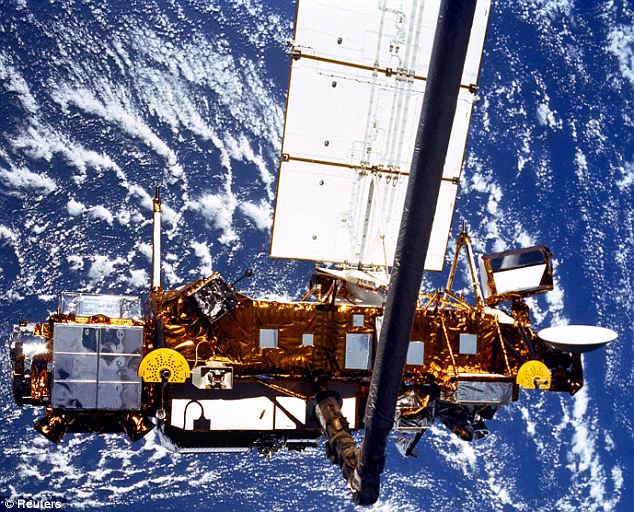A satellite, weighing six tons and currently out-of-control, will strike Earth at 18,000 mph and could land almost anywhere this evening – NASA warned last night.
The satellite has the size of a bus and will break up on entering Earth’s atmosphere, flinging huge chunks of metal weighing up to 350 lb (150 kg) across hundreds of miles.

NASA said its specialists will only know two hours before impact where it will land – and even that prediction will only be accurate to the nearest 6,000 miles. The satellite could land anywhere between the 57th parallel north, which crosses Britain at around Inverness, and the 57th parallel south, which passes just below South America.

The plummeting six-ton satellite has been caught on film.
Astrophotographer Thierry Legault’s clip, shot in northern France, shows the 20-year-old Upper Atmosphere Research Satellite (UARS), appearing as a beaming mass of light as it careers to Earth.
[youtube TPP766kxU1U]
NASA orbital debris scientist Mark Matney admitted:
“We know it is going to hit somewhere between 57 north and 57 south, which covers most of the inhabited world, unfortunately.”
However, scientists have ruled out the Upper Atmosphere Research Satellite striking North America.
The satellite orbit has been altered by NASA deliberately to make it crash – but it is now coming down sooner than expected due to changed atmospheric conditions.
The satellite is falling to Earth at 5 miles per second, faster than previously thought and experts say there is a one in 3,200 chance of someone being hit by debris – more likely than getting a hole in one during a round of golf.
The NASA satellite, which measures 35ft (12 meters) and weighs 6.5tonnes, was put into space in 1991 to monitor climate change, and ceased its operations in 2005.
The falling satellite will look like a fiery meteor shower as it begins to burn up in the atmosphere.
It is expected that satellite will break into more than 100 pieces with most of it being destroyed before it hits the ground. But around 26 pieces are expected to make it through and the heaviest metal parts are expected to reach Earth, including titanium fuel tanks.
NASA spokesman Steve Cole said:
“Anybody who finds a piece of the satellite should stay away from it and call the police and let them deal with it.
“It could be very hot or it could be dangerous. It depends on what speed the debris is going, but it could go be going fast enough to go through a house.
“We will have to wait and see if the debris creates a crater. If it is spherical that is possible but if it has a less regular shape it may not be going so fast.”

Steve Cole added that more accurate predictions are expected throughout today and will be posted on NASA’s website.
Debris routinely falls to Earth from space but the Upper Atmosphere Research Satellite will be the biggest NASA craft to fall uncontrolled from space in 32 years.
In 1979, Skylab, which was 15 times bigger, rained charred chunks on the Indian Ocean and Western Australia after NASA said it would land in South Africa.
In 2003, when the space shuttle Columbia exploded upon re-entry killing its entire crew, large chunks of its shell landed across Texas.


